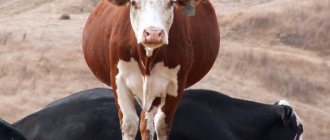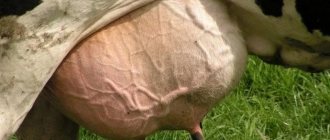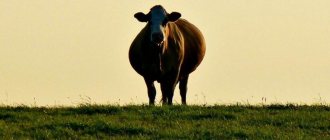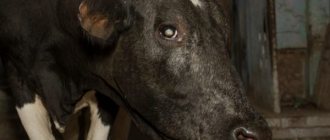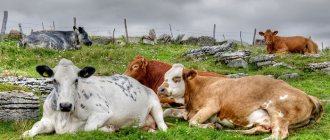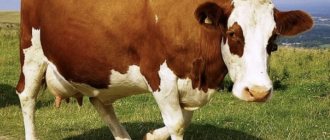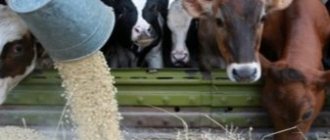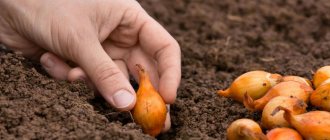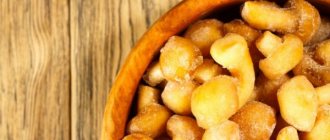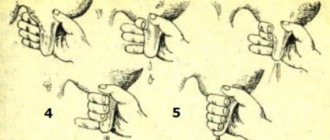What is launch and why is it needed?
Cattle are kept on farms, of course, primarily to produce milk. However, before the calf is born, the cow must rest a little from milking. In this case, she will subsequently produce healthy offspring, and then will produce high-fat milk in large quantities. The period in which the cow is not milked before calving is called the start.
Basic Rules
Under no circumstances should the technology for launching drills be violated. This is fraught with the development of mastitis and other udder diseases in cows. First of all, at the start of the launch, the animal is transferred to a special diet. Cows exclude juicy food and some concentrates from the menu. Such products are replaced with roughage, that is, hay. The animal is given no more than 1 kg of concentrates per day.
In the summer, when starting, the grazing time is reduced. After all, grass can also be classified as succulent food. Cows are driven out to pasture during this period, but the time spent in the meadow is gradually reduced to 4-5 hours.
As soon as the cow is switched to dry food, they begin to gradually reduce the number of milkings. This leads to burnout of the animal's milk. Over the course of 1-2 weeks it becomes less and less. Eventually, milking stops altogether.
Milking mode
Before starting a cow, it is necessary to decide how to reduce milk production and what method to choose. Experts differ on the mode of milking cows at startup.
Read also: How to attach wooden balusters and railings
Some argue that it is necessary to gradually reduce the number of milkings. At the same time, do not milk the milk completely, leave a little in the udder. The animal’s body will understand that it does not need to produce a lot of milk and will stop producing it. The technique is very risky. Remaining fluid in the mammary gland can cause mastitis. It will have to be treated before the animal is transferred to dry wood. During the next lactation period, productivity may decrease.
Did the article help? Rate it
( 1 ratings, average: 5.00 out of 5)
Rules for walking pregnant cows
The time a pregnant cow spends on pasture is thus reduced. However, it is believed that short walks in the meadow can be very beneficial for such cows. It is recommended to take pregnant animals outside from time to time not only in summer, but also in winter. In the period from October to April, the cow should spend at least half an hour a day in the fresh air before calving. For this purpose, a walk is organized next to the barn. Its area should be such that each cow has at least 8-9 m2.
It is not recommended to let pregnant cows out together with non-pregnant cows. This can lead to injury and abortive processes. Experts also do not recommend letting pregnant cows out into the wild during icy conditions. If a pregnant cow slips, this can also lead to a miscarriage. You should, of course, walk cows very carefully even in the last months of gestation. Such animals on the street need to be monitored more closely.
Rules of care
During this period, the animal should be in a dry, warm stall.
If the process occurs in the summer, then the cow's grazing is temporarily stopped or reduced to 2 hours a day. The udder is washed regularly. It is important not to miss the moment if the animal develops mastitis, and to begin treatment on time. Important! Mastitis is detected by palpation when massaging the udder before milking. Its signs: swelling of the udder, redness, pain, hardening, abnormalities in the milk.
Juicy feeds are excluded from the diet, replacing them with poor hay. It is called poor because it is depleted in nutrients. This hay is harvested after the grasses flower and bear fruit, in the second half of summer.
The rate of straw and hay can be increased. Concentrated feed should not exceed a volume of 1 kg. A cow needs to be fed three times a day. Drinking is also limited to one bucket of water per day. Once lactation has stopped, feeding continues according to the dry period pattern.
Timely starting of the cow reduces the risk of abnormal development of the calf and guarantees high-quality lactation after calving. The launch method depends on the milking capacity of the animal and is chosen by the farmer, but whatever it is, it must be carried out.
Under no circumstances should the technology for launching drills be violated. This is fraught with the development of mastitis and other udder diseases in cows. First of all, at the start of the launch, the animal is transferred to a special diet. Cows exclude juicy food and some concentrates from the menu. Such products are replaced with roughage, that is, hay. The animal is given no more than 1 kg of concentrates per day.
In the summer, when starting, the grazing time is reduced. After all, grass can also be classified as succulent food. Cows are driven out to pasture during this period, but the time spent in the meadow is gradually reduced to 4-5 hours.
As soon as the cow is switched to dry food, they begin to gradually reduce the number of milkings. This leads to burnout of the animal's milk. Over the course of 1-2 weeks it becomes less and less. Eventually, milking stops altogether.
The time a pregnant cow spends on pasture is thus reduced. However, it is believed that short walks in the meadow can be very beneficial for such cows. It is recommended to take pregnant animals outside from time to time not only in summer, but also in winter. In the period from October to April, the cow should spend at least half an hour a day in the fresh air before calving. For this purpose, a walk is organized next to the barn. Its area should be such that each cow has at least 8-9 m2.
It is not recommended to let pregnant cows out together with non-pregnant cows. This can lead to injury and abortive processes. Experts also do not recommend letting pregnant cows out into the wild during icy conditions. If a pregnant cow slips, this can also lead to a miscarriage. You should, of course, walk cows very carefully even in the last months of gestation. Such animals on the street need to be monitored more closely.
It is best to carry out this procedure in the morning - before the first feeding. At this time, the cow's stomach empties. Accordingly, palpation in the morning is much easier.
To ensure that the cow experiences less discomfort, before performing diagnostics using this method, the fingers can be additionally lubricated with Vaseline oil. In any case, palpation should be done as carefully as possible. The walls of the rectum in cattle are quite thin. And any careless movement can easily damage them.
You cannot move your hand during palpation at the moment of contraction of the intestinal walls. In order to conduct a study on the position of the uterus, you need to wait until they are completely relaxed.
So, we found out how to properly start a cow on the farm. Just before calving, cows on farms are kept mainly on roughage. In a household, the cow menu during this period, for example, includes:
- silage and cereal hay - 60%;
- concentrated feed (grain, bran, mixed feed) - 24%;
- other types of roughage (regular hay) - 16%.
Animals are usually given food before calving 3 times a day. Also, when performing the starting procedure, the cow must be offered 30-50 g of chalk and salt per day. Of course, a pregnant cow should be given only high-quality food without mold or bad odor. Otherwise, the cow may miscarry.
There are careless owners who believe that since a cow does not give milk at launch, it is not necessary to feed it well. This approach is fundamentally wrong. Poor feeding of the animal during the launch period can lead to, for example, negative consequences such as:
- difficult calving;
- diseases of the udder and reproductive organs;
- delayed placenta, etc.
Among other things, before giving birth, a cow, of course, also needs to be provided with decent living conditions. The cow should be kept in a warm, bright, well-ventilated barn.
Having a cow in a household is a profitable business. A healthy cow produces a large amount of nutritious milk and bears offspring. But the animal must be properly cared for. Among the basic rules are:
- The barn or barn should be in a quiet place. Cattle, despite their large size, are quite shy. Any stress can negatively affect the health of the animal and its milk.
- The barn should be warm, clean and constantly ventilated. A thick layer of straw is placed on the floor. It is necessary to have feeders in the form of mangers and compartments with clean water. The floor should be at a slight slope. This is done to prevent slurry and manure itself from accumulating in the stall.
- In summer, cows are turned out to pasture. There they spend the entire daylight hours. At night they are driven into a stable.
- The cattle are fed in the morning and evening. The summer diet contains mixed feed, mash, and grain feed. In winter, feeding becomes more nutritious, since animals do not go out to eat fresh grass. The winter diet consists of mixed feed, bran, cake, silage feed, hay, potatoes, carrots and other root vegetables, and pumpkin. Regardless of the time of year, heifers and bulls should have clean water at room temperature. The average water consumption per individual is from 15 to 40 liters daily.
- Experienced breeders advise accustoming the animal to a daily routine. Feeding, walking, milking, and cleaning should be done every day at the same time.
- A cow should be milked 2-3 times a day, provided that she produces at least 10 liters of milk. Breeds that produce less milk are milked once a day.
We invite you to familiarize yourself with: Determination of the daily milk yield of a cow
Additional Information! The food should be balanced and include vitamins. To do this, table salt, bone meal, spruce branches, and industrial vitamin complexes are added to food.
special instructions
Cows are watered during startup most often as usual. But sometimes it happens that even after changing the diet, the animal produces the same amount of milk as before. In this case, the number of times the cow is given water is reduced. This animal is given water three times a day.
Of course, you need to water a pregnant cow correctly. Pregnant cows are given exceptionally warm water. Using too cold or hot may cause miscarriage.
During the period of starting a cow before calving, among other things, it is necessary to monitor the condition of her udder. If it hardens, you should contact your veterinarian immediately. Otherwise, the cow may develop mastitis. If this happens, the launch should be stopped until the animal has fully recovered.
You can prevent the development of mastitis in a cow, among other things, by periodically massaging her udder. It is necessary to carry out this procedure from time to time before starting.
Care and feeding
A pregnant cow requires a lot of attention. It must be kept warm, in a clean stall, where there is no dampness or draft. During the dry period, the animal needs daily hygiene - the skin should be brushed and the udder should be washed with warm water. It is important to keep the litter clean. During pregnancy, the cow should walk a lot - if possible 2-3 times a day for an hour. This will avoid complications after childbirth in the form of udder swelling and other pathologies.
Carrots for cows
The diet of a pregnant cow during the dry period should include:
- Good quality meadow hay.
- Root vegetables - carrots, potatoes, beets.
- Juicy food.
- Concentrates.
- Vitamin supplements (chalk, salt).
Important! The quality of the food supply must be strictly controlled - it is unacceptable to give the animal rotten hay, rotten vegetables, or sour food. You cannot give a cow cold water - sometimes this leads to miscarriage.
The health of the future offspring, as well as the productivity of the animal, depends on the timeliness and correctness of the start of the cow. The ideal time to start transitioning to dry cows is 2 months before calving. If the cow's milk yield is large, over 10 liters of milk per day, the start should be started earlier - 60-75 days before giving birth. If lactation does not stop, despite dietary restrictions and changes in the milking schedule, it is necessary to use medications to start the cow.
We suggest you read: Cat behavior before giving birth for several days. How cats behave before giving birth: harbingers of childbirth. Correct birth process
To properly organize the start-up, dry-off and calving periods, the farmer needs to keep a calendar that marks the cow's mating time. This will help you accurately calculate all the required dates.
If calving occurs earlier or later than the expected date, this depends on the characteristics of the cow and is considered acceptable. Normally, resolution of the burden occurs on the 285th day. Taking into account possible deviations, it is believed that calving can occur in the period of 265–300 days.
The animal's rest period from lactation must be at least 60 days. During this period, it is necessary to carefully monitor the diet and maintain the necessary conditions in the room. It should be illuminated, and the litter should be kept dry and updated daily.
Feeding should be carried out according to the schedule. The water should be clean and slightly colder than the room temperature. Feed mixtures should contain a large amount of minerals and vitamins. If the cow eats little, then the feed is diluted with fresh grass and greens.
Diet
During the period of starting a cow before calving, the artiodactyl should gain 60-65 kg in weight. Hay is suitable for feeding in the initial period to prevent overeating. She is also given a small amount of water at this time.
It is better to feed a cow at startup after the udder has dried out with the following products:
- chalk;
- bran;
- salt;
- special feed for prenatal cattle.
A month before the end of the launch period, the diet should include:
- feed mixtures for calving cattle;
- crushed corn;
- pressed sunflower seeds;
- processed beets.
If you follow the correct diet for cattle during launch, the productivity of the individual will remain at the same level. Also, the period of absence of lactation will not affect the condition of the artiodactyl. If there is an excessive amount of drinking water, the female will produce a large amount of milk in the first month.
The starting time is selected for each cow individually. It is determined by the following factors.
- Estimated calving date. There are formulas and tables to determine or calculate it.
- The age of the cow. The first heifer should be stopped milking gradually over a longer period.
- Milk productivity. Cows that produce a lot of milk are started more slowly.
Based on the above factors, the optimal start-up or dry period would be:
- for first-calf heifers and cows of high milk productivity - three months;
- for animals with average milk production - two or two and a half months.
The minimum duration of the dry period can be forty days.
This is achieved in the following way:
- changing your diet;
- stopping milking;
- decreasing (if milk production does not stop) the amount of water;
- reducing grazing time (if the start occurs in the summer).
During this period, special attention should be paid to the animal’s udder. Constantly inspect and feel it. If it becomes hard, do not hesitate to contact your veterinarian for help. If time is lost, the cow will develop mastitis. To prevent milk from stagnating and this disease from occurring, massage the udder.
How long can it last
The number of milkings before calving is usually reduced from two per day to one. For cows with average milk yield, the start-up procedure most often lasts no more than 5 days. However, they usually stop milking such animals only on the 7th day. In most cases, private farms use the following scheme for starting cows before calving:
- 1st day - two milkings;
- 2nd - 2 milkings;
- 3rd and 4th - milking only in the morning;
- 5th and 6th - only in the evening.
On the seventh day, the animal is milked for the last time in the morning. How long a cow should be kept on a private farm - the answer to this question depends primarily on its individual productivity in terms of milk yield. They stop milking a pregnant cow when her udder decreases in size and the amount of milk in it drops to one glass. By this time, the risk of developing mastitis will be reduced to zero.
Stopping milking
Milking is stopped when milk is no longer produced and the cow's udder decreases in size.
Starting procedure for cows with average milk yield
In cows with milk yields of up to five liters, this usually occurs on the fifth day. But they stop milking them on the seventh day. They operate according to this scheme.
After this time, after the udder has shrunk and the milk has stopped remaining, the start-up procedure is considered complete.
Starting procedure for cows with high milk yield
For high-yielding cows that produce 15 liters of milk per day, a week may not be enough for the start-up procedure. Then it lasts for two or two and a half weeks. This is due to the fact that they do not stop producing milk for a long time. But it must be done. Otherwise, improper starting will negatively affect subsequent births and future milk yields.
Dairy cows need to greatly reduce the proportion of high-calorie concentrated and succulent feed in their diet. If the launch occurs in the summer, then they do not need to be turned out to pasture.
Changes are made to the milking scheme to start the start. Twice milking is extended by four to five, or maybe more days. When the cow begins to produce three liters of milk, she can be transferred to a milking scheme for cows with average milk yield. See table above. It is necessary to stop milking at the same time as for low-yielding animals. That is, after the udder decreases in size and there will be almost no milk in it.
Sometimes dairy cows will not stop producing milk. Then they resort to forced launch.
How to milk high-milk cows
In such animals, the starting procedure usually takes longer. Most often, milk from high-yielding cows disappears only after 2 or even 2.5 weeks. How many times should a high-yielding cow or first-calf be milked during start-up? In such animals, milk will, of course, take longer to burn out. Therefore, twice-daily milking after changing the diet in this case is usually extended by 4-5 or more days. The cow can then be placed on the same schedule as for mid-milk cows. They also stop milking such animals only after the udder has shrunk and the amount of milk has dropped to a glass.
Placentation in cows
When does placentation occur in cows? The process of placentation in cows begins 18-27 days after fertilization. The placenta is a unique organ that connects the mother with the fetus. Thanks to him, the fetus can breathe and receives the necessary nutrition. It is the placenta that protects the developing body from pathogenic microbes and bacteria. Placentation is the formation of the placenta. This process is inextricably linked with implantation.
We suggest you read: Worms in cows, symptoms and treatment
When does implantation occur in cows? Implantation occurs during the formation of the placenta. This process involves the attachment or ingrowth of the fetus into the uterine mucosa with the help of the developing placenta. It usually takes about 50 days.
How to determine if a cow is pregnant
It is believed that cows of any breed should be started no earlier than 3 months before calving and no later than 45 days before that. But of course, you need to start this procedure only if the animal is really pregnant.
Cows of almost all modern dairy breeds reach sexual maturity at approximately 1.5 years of age. At this time, cows are usually mated with bulls. A cow can be considered pregnant if she does not show signs of heat 3-6 weeks after covering.
In a household, you can determine if a cow is pregnant by the following signs:
- careful behavior and a quieter lifestyle while maintaining appetite;
- the presence of vaginal discharge in the first couple of months;
- changing the texture of the coat to a smoother and shinier one.
A good answer to the question of how to determine if a cow is pregnant is, of course, palpation. The procedure is complex, but even in a private household it is quite doable. Palpation is usually performed as follows:
- a couple of assistants should hold the cow by the horns and legs;
- the examiner soaps his hand and inserts it into the animal’s rectum;
- Having felt the cervix, the examiner controls its position.
In a non-pregnant cow, the uterus will be located in the pelvic area. In an animal that is pregnant for 2 months, one horn increases in size and fluctuates. Of course, in a pregnant cow, the uterus itself will be quite large.
Running a cow
04/01/2019 A cow, as you know, is not milked all the time. Her body requires time to recover and prepare for the next lactation. If fertilization of the animal is successful, the cow is in a state of pregnancy; otherwise, it goes into the barren category.
Barrenness
- this is more of an economic concept and it means a shortage of calves in the calendar year. For example, if out of 10 cows in a year only 7 gave birth, then the barrenness rate was 30%. Barrenness can be caused by various factors. The most common of them are: diseases of the reproductive system, abortions, etc. Livestock breeders usually call a cow a cow that has not been fertilized in due time, that is, has not become pregnant, although it is already time for it. Such “problem” cows usually either do not come into heat at all, or come but do not become pregnant after insemination. A veterinarian must understand the reasons, individually in each case, but this is a completely different topic.
Launch
is a technological process that rearranges the physiological processes in the body of a lactating (milk) cow, forcing it to stop producing milk.
Usually the start begins at the end of pregnancy, with the expectation that by the end of the seventh - beginning of the eighth month the cow will no longer produce milk. You only need to start a pregnant cow
!
It doesn’t make any sense to start a barn cow At the same time, it is necessary to understand as soon as possible the reason why the cow is not inseminated. Otherwise, she will turn from a wet nurse into a freeloader!
Launch
the dry period
that follows is not only a technological stage in milk production, but also a natural, obligatory part of the animal’s natural life cycle. According to scientifically based requirements, which are confirmed by centuries-old animal husbandry practice, a cow must rest for at least 45–60 days before calving. Exactly how much: 45 or 60 depends on many factors, but primarily on the productivity of a particular animal and the priorities of the owner himself.
It happens that among livestock owners there are those who, in pursuit of profit, milk their cows almost until calving. This practice ultimately results in a decrease in the amount of milk in a new lactation, the birth of weak young animals and exhaustion of the cow’s body. A weakened animal is more susceptible to various diseases, which means that expenses (possibly considerable!) for its treatment are predicted to arise. In addition, the total life of the cow will be reduced.
Now in more detail about the objective reasons influencing the successful implementation of the launch. The more productive the cow, the more difficult it is to start her, and the longer this process takes. This must be taken into account when planning the start date for the launch process. When we talk about 45 - 60 days, we mean that by this time the cow is already completely neglected, and milk is not produced in the mammary gland.
All cows by difficulty of launching
can be roughly divided into
four groups
.
First group
- these are those cows that have low productivity or, due to their hereditary and physiological characteristics, gradually reduce their daily milk yield, starting from the fifth to sixth month of pregnancy, and by the eighth month they completely stop producing milk. The number of such animals is small. Moreover, this quality is not desirable for a productive farm. Low-yielding cows are more preferable for keeping on a homestead farm, since they do not require high professional qualifications on the part of humans.
Second group
– these are cows that have high or average productivity. They are very responsive to feeding influences, and the amount of their daily milk yield is easily regulated by diet. These animals are relatively easy to start on time and are the most desirable for keeping both on a dairy farm and in a household. They make up the majority in the dairy herd. Their average milk yield fluctuates at 20 liters per day. You can breed such an animal without threatening the health of the mammary gland in about two to three weeks.
Third group
- These are mainly cows of specialized dairy breeds with very high productivity and a uniform lactation curve. They give a lot of milk, and when the nutritional value of the diet decreases, they continue to produce it at the expense of their body’s reserves. Starting up is difficult and takes a long time. It takes at least a month to launch, and sometimes more. Cows with such characteristics require special attention and extensive experience from breeders.
Fourth group
cows are very rare.
These are animals of average, but often high productivity, which cannot be fully started until the very next calving. As a result of the efforts of the owners and veterinary staff, the animals reduce their milk yield to three to four liters per day. Sometimes it is possible to milk them every other day, but the milk continues to arrive, as a result of which there is a threat of mastitis
.
How to launch a cow without the risk of mastitis and stress for the animal and its owners? The first step is to accurately classify which of the above groups your cow belongs to. The start time of the startup process will depend on this. After the final determination of the date, I recommend diagnosing hidden mastitis, separately for each quarter of the udder. Detailed instructions for testing a cow for mastitis are described in my article on this topic.
If mastitis is detected, it must first be cured, and only then the animal can be started. It is also recommended to conduct a rectal examination for pregnancy to be on the
your cow, if it has not been done before. Such an event is necessary to avoid a possible situation where a cow was successfully launched, but at the allotted time for calving it turned out that she was not pregnant. The simplest and most accurate diagnosis of pregnancy is rectal. Other indirect signs (milk, appearance, appetite, etc.) do not provide any guarantee of pregnancy. Diagnostics using ultrasound gives good results, but such a service is not provided everywhere in our country.
If convincing evidence of the cow’s pregnancy is obtained, then the start begins with a gradual reduction in the amount of concentrates and succulent feed in the animal’s diet. By the end of the first week they are completely excluded. Instead of succulent feeds and concentrates, the share of coarse feeds is increased, and not at the expense of high-quality and easily digestible hay, but at the expense of coarse hay and good quality barley or oat straw. In the summer, the cow is simply grazed on old grass, limiting it to any other feed. As a result of such feeding, daily milk yield, as a rule, is significantly reduced, and the cow can be transferred to milking twice a day: in the morning and in the evening. And the cow of the first group even gets a one-time meal – in the morning.
During the second week, the animal is no longer given bean hay, replacing it with cereal or straw. If a further decline in daily milk yield does not progress, then watering should be reduced by 30–40% of the usual norm. By the end of the second week, in most animals the amount of milk decreases so much that they can be milked once a day. During this period, the cow of the first group can be milked several times in one or two days and then started completely. But it is necessary to take into account the degree of filling of the udder.
By adhering to a low-calorie diet, we further reduce milk synthesis in the cow’s mammary gland and by the end of the third week we switch to milking every other day. You should not be afraid of short-term “malnutrition” on the part of the cow. Such a diet is necessary for restructuring the physiology of the animal’s body, and it will not cause harm to it. Much worse consequences for the cow during startup will occur if the cow is fully fed and the udder is overcrowded.
Throughout the fourth week we milk the cow every other day or every two days on the third. If her udder has decreased in size and there is no reflex to fill it at the usual time for milking, then milking the cow can be completely stopped. I recommend sticking to a meager diet and limited watering for a few more days, up to a week, after which you gradually switch to a regular diet for dry cows. Completion of the startup process can be considered successful if there is no filling of the udder during the transition to normal feeding.
All time frames in this step-by-step instruction are very approximate as they are individual for each cow. When carrying out work, you should definitely monitor the condition of the animal’s mammary gland and focus on this factor, and not on the timing.
For cows of the third and fourth groups, the described technique will extend over time. In addition to it, at the end of the entire process, you can use special intrauder preparations (one syringe tube is inserted into each nipple through its hole), which will prevent the development of mastitis. Good results are given by “Bayoclox DC”, “Orbenin EDC” and “Nafpenzal DC”.
These medications contain antibiotics and should not be administered more than 42 days before calving. They are used to quickly force the start of cows on livestock farms with intensive milk production technology.
Have a successful launch!
If you have any questions while reading this material, you can ask them on our forum. Chuguevets Vitaly
Rules for performing palpation
It is best to carry out this procedure in the morning - before the first feeding. At this time, the cow's stomach empties. Accordingly, palpation in the morning is much easier.
To ensure that the cow experiences less discomfort, before performing diagnostics using this method, the fingers can be additionally lubricated with Vaseline oil. In any case, palpation should be done as carefully as possible. The walls of the rectum in cattle are quite thin. And any careless movement can easily damage them.
You cannot move your hand during palpation at the moment of contraction of the intestinal walls. In order to conduct a study on the position of the uterus, you need to wait until they are completely relaxed.
Feeding just before birth
A week before calving, concentrates are completely excluded from the diet of well-fed cows. For thinner animals they are given in quantities of no more than 900 g per day. What is the best way to feed cows during this period? The answer to this question, of course, interests many farmers. During this period, in order for the calf to receive all the vitamins, microelements and nutrients necessary for its body, its mother’s menu should definitely include bean and cereal hay, rich in fiber and beneficial components. This kind of feed should be given to cows in abundance at this time.
One-step medicinal technology
Using this technology, there is no need to alternate the number of milkings. A cow's milk production stops after injections of special drugs into the udder:
The algorithm of actions for this technology is as follows.
- They begin preparing the cow for launch exactly seventy days before the expected calving.
- The cows eat hay for ten days. Silage and energy-intensive feeds are excluded from the diet.
- The milking regime during this period remains at the same level.
- The condition of the udder is monitored. The goal is not to miss hidden mastitis. If it is detected, stop running the cow until it is cured.
- With dry feeding, milk yield should decrease.
- If the cow is healthy, if the milk yield is less than ten liters, on exactly the sixtieth day, inject special medications into each lobe of the udder.
- Stop milking the cow immediately and do not resume until calving.
- The udder will swell slightly. This is fine. The swelling will go away in a few days.
- After the swelling subsides, the cow is transferred to dry housing. The diet is supplemented with silage and concentrates - up to two kilograms.
The advantage of this method is that it eliminates the possibility of untimely starting of the cow. This means that the risks of fetal underdevelopment and decreased milk production in the future are reduced. In addition, after the administration of these drugs, cows practically do not suffer from mastitis.
Instant launch
On large farms, it can, of course, be difficult to pay attention to each pregnant cow before giving birth. Therefore, on such farms they usually use special preparations to immediately start cows before calving. In this case:
- The cow's diet is changed approximately 50 days before calving;
- after 10 days, milk is taken from each nipple for analysis to identify pathologies.
On the day of launch, before calving, the cow is thoroughly milked and wiped dry, and her udder is also disinfected. Next, using a dispenser syringe, an anti-mastitis drug is injected into the animal’s mammary gland through the nipple. This could be, for example, “Orbenin” or “Nafpenzal DC”. In this way, each quarter of the udder is pumped with the drug. After this, milking of the cow is stopped and the animal is transferred to dry land. The diet includes concentrates and silage in quantities of up to 2 kg per day.
The animal is usually given injections of anti-mastitis drugs at start-up only if it is healthy and when milk production has decreased to 10 liters per day. On the first day after using the drug, the cow's udder may swell. But this phenomenon is temporary and does not lead to any negative effects.
The main advantage of the instant method is that it eliminates the possibility of an untimely start of the cow. In addition, those animals that were injected with a drug intended for this purpose are much less likely to suffer from mastitis in the future.
Preparation before calving
When breeding cows, the farm owner understands how important it is to properly prepare for calving. The health of future offspring, and therefore profit, depends on this. A pregnant cow needs good care and proper nutrition throughout the entire pregnancy period. However, to increase her milk yield after calving, you need to give her rest and stop milking 1.5-2 months before giving birth. During this time, the cow will replenish vitamin and mineral reserves and gain strength, which will contribute to increased productivity during the upcoming lactation.
Preparation before calving necessarily includes starting the cow. It is carried out 60-75 days before the expected date of birth. Individuals that produce more than 10 liters of milk daily should be started earlier than others, because their body requires more time to stop lactation. To start a cow in the summer, it is necessary to change the diet, excluding succulent feed and concentrates from it, and milking according to a certain pattern. In the first days of launch, the animal is milked twice a day, then once a day, and after milk production almost stops, milking is stopped completely. There are two ways to start a cow:
- Gradually (by changing your diet).
- Forcibly (with the help of medications).
Reference. The second method of stopping lactation is used if the cow is a heifer or produces more than 10 liters of milk per day.
What is the danger of untimely launch?
The individual characteristics of some cows are such that it can be very difficult to start them before calving. When switching to dry food, a cow, for example, may experience gastric arrest, which often even leads to the death of the animal. Often, even when succulent feed is excluded from the diet, the cow continues to produce large amounts of milk. In such cases, some homestead owners refuse to breed an animal. Of course, quite often this does not lead to any negative consequences. However, allowing a cow to give birth without starting it is still quite dangerous.
You should definitely try to prepare even a problem animal for childbirth. Such a cow should be transferred to dry food carefully, gradually reducing the amount of succulent food in the diet. To stop lactation in this case, as already mentioned, you can use special drugs.
Incorrectly starting a cow before calving or ignoring this procedure can lead to such unpleasant consequences as:
- abnormalities in fetal development;
- significant reduction in milk yield in the post-calving period.
The amount of milk in a cow after calving will decrease if she was not started properly, maybe up to 40%.
Start of launch
Starting a cow is an important procedure that requires preparatory operations. Females need to be launched 55-65 days in advance. If calving occurs for the first time, then the period is increased to 80-90 days, provided that the cow produces many liters of milk.
Preparatory procedures begin 2 months in advance, but not too early, so as not to harm the body. Cows with good milk yield are introduced gradually.
Preparation includes the following operations:
- reducing the feed consumed by animals to 1 kg per day;
- exclusion of succulent feed from the diet;
- reducing the number of milkings of a cow to 2 times a day.
After 3 days from the start of the start, the cows switch to milking once a day and gradually stop it. It is also allowed to take milk once a day after 2 days from the start, if the need arises.
During the launch, cows' milk production is stopped after 50-60 days with a small number of liters of milk and after 90 days for animals with high milk yield. If you start a cow correctly before calving, her milk will gradually begin to flow. This forces the animal to reduce the amount of fluid it consumes and add roughage to the diet.
Early launch
Sometimes it happens that a cow’s lactation period, on the contrary, ends too early - 3-3.5 months before calving. For the cow itself and its fetus, early starting is usually not harmful. But the owners of the farmstead in this case, of course, do not receive quite a large amount of milk.
Why does a cow start early? In most cases, early cessation of lactation does not mean that the animal has any pathologies. This usually happens simply because of the individual characteristics of the body of this particular cow. To extend the lactation period of such an animal by about a month, experienced farmers advise giving a cow prone to early starting more succulent feed. This could be, for example, silage, beets, fruits, carrots, etc.
Deadlines
Timing at startup is very important. As a rule, it starts no later than 2 months before the cow calving. It must be taken into account that first-calf heifers or high-yielding cows start early, at least 80-120 days before giving birth. Moreover, it must be taken into account that only a few owners can accurately calculate the calving date. It is important to take into account the error, which can be 10-14 days.
In order to best calculate the time of starting cattle before calving, you should use a special calendar and schedule. Every cow owner should learn how to use them, especially since they are time-tested. The average period from insemination of an animal to calving is 285 days, that is, 9-9.5 months. Based on this, it is already possible to calculate the optimal launch time.
Please note that the start time may vary depending on the milk yield of the cow. For example, if a cow produces an average of 16 liters of milk per day, then it will take a week or a little more to start. For higher-yielding representatives, producing 25 or more liters per day, it will take about two weeks to start. In any case, one primary task arises - to gradually reduce milk productivity to zero.
In the event that a cow’s milk yield has independently decreased to 3-4 liters per day, then it must be started quickly . At this time, the composition of the milk changes, in particular, the fat content and proteins decrease. The taste of the product may also change, for example, a salty taste will appear. During this period, if the cow is under constant control, then everything will go fine.
Sample menu and care
So, we found out how to properly start a cow on the farm. Just before calving, cows on farms are kept mainly on roughage. In a household, the cow menu during this period, for example, includes:
- silage and cereal hay - 60%;
- concentrated feed (grain, bran, mixed feed) - 24%;
- other types of roughage (regular hay) - 16%.
Animals are usually given food before calving 3 times a day. Also, when performing the starting procedure, the cow must be offered 30-50 g of chalk and salt per day. Of course, a pregnant cow should be given only high-quality food without mold or bad odor. Otherwise, the cow may miscarry.
There are careless owners who believe that since a cow does not give milk at launch, it is not necessary to feed it well. This approach is fundamentally wrong. Poor feeding of the animal during the launch period can lead to, for example, negative consequences such as:
- difficult calving;
- diseases of the udder and reproductive organs;
- delayed placenta, etc.
Among other things, before giving birth, a cow, of course, also needs to be provided with decent living conditions. The cow should be kept in a warm, bright, well-ventilated barn.
Productive longevity of cows
A cow can calve about 4-9 times throughout her life. Productive longevity depends on the characteristics of the content. A healthy heifer will be able to bear offspring annually for 7-9 years. At the same time, when calving, she will feel quite well, and she will not experience any complications. An individual with a weakened immune system will also be able to bear and give birth to calves, but there will be fewer offspring.
Advice from experienced livestock breeders regarding the productive longevity of cows:
- Observe the life cycles of cattle. Transit and service periods cannot be excluded.
- During pregnancy, you should carefully care for your pet and properly launch the individual.
- It is necessary to take proper care of your pet. Keep it in a clean, ventilated area, let it go out to pasture in the summer, feed it with quality food and drink clean water.
Additional Information! The average life expectancy of a cow is 10-16 years. It has been established that cows with caring owners at home live longer than those on farms.
Read also: Treatment of potatoes against late blight
What to do after calving
Pregnancy in cows can last about 280-310 days. Thus, the answer to the question of when to stop milking a cow before calving is approximately 7.5 months. Of course, cow cows need good care not only before calving, but also after it. In any case, the normal diet for the animal should be returned gradually.
30-40 minutes after the cow gives birth to her calf, she needs to be given a sufficient amount of water to drink. Then fresh, clean, high-quality hay should be placed in the feeder for the cow. In summer, it is allowed to give freshly calved cows green grass.
Concentrated feed is usually introduced into the animal’s diet one day after birth. In most cases, at this time, cows are given the simplest, not too high-calorie bran mash with water. On the third day, such food can be replaced with oat mash in the amount of 1.5 kg. Such food will be useful especially for constipation in a cow after giving birth.
Juicy feed, like concentrated feed, is gradually introduced into the animal’s diet after calving. It is impossible to give a large amount of such food to cows. Otherwise, they may experience more than just udder disorder. Too high a percentage of succulent feed in the diet after calving often, unfortunately, causes udder swelling.
Feeding at startup
Many homesteaders substitute the definitions of “launch” and “dead wood”. During the dry period, the animal is prescribed a balanced diet, in which the amount of succulent feed is reduced. The diet must include supplements with minerals and a small amount of concentrates with premixes. The premixes contain a balanced composition of vitamin and mineral complexes.
Special feeds are selected for pregnant cows. The purpose of the diet for dry animals is to ensure the full development of the fetus, minimize complications of calving and pathologies after the birth of a calf, and maintain the health of the cow.
Feeding at startup is limited to feeding hay and water. Juicy feeds, grain mixtures, and combined feeds are excluded from the diet. Animals receive meager feeding. The calf will not be harmed. The period does not last long. This is necessary to reduce milk production in the mammary gland.
On large farms, start-up cows are kept together with cows that have recently calved. They have the same diet. The milking schedule is different.
- Animals with low productivity are kept on hay and water for 7 days.
- With high milk yields – 14 days.
- This diet cannot be called balanced, but it is a necessary measure to stop milk production.
- Animals are given water up to 20 liters per day in winter, and 25-30 liters per day in summer.
In summer, cows are also given hay when starting out. Their walking is limited to 4 hours a day. For grazing, pastures with sparse vegetation are chosen, but it is necessary to first check it for the presence of foreign objects. Otherwise, the cow may swallow a wire or a piece of metal, which will lead to injury to the gastrointestinal tract.
Select vegetation of a certain length: stem height 6-7 cm. Low grass will be inconvenient for the animal to grip. Together with it, it can eat a large amount of sand and soil, which will lead to pathology in the rumen or book.
